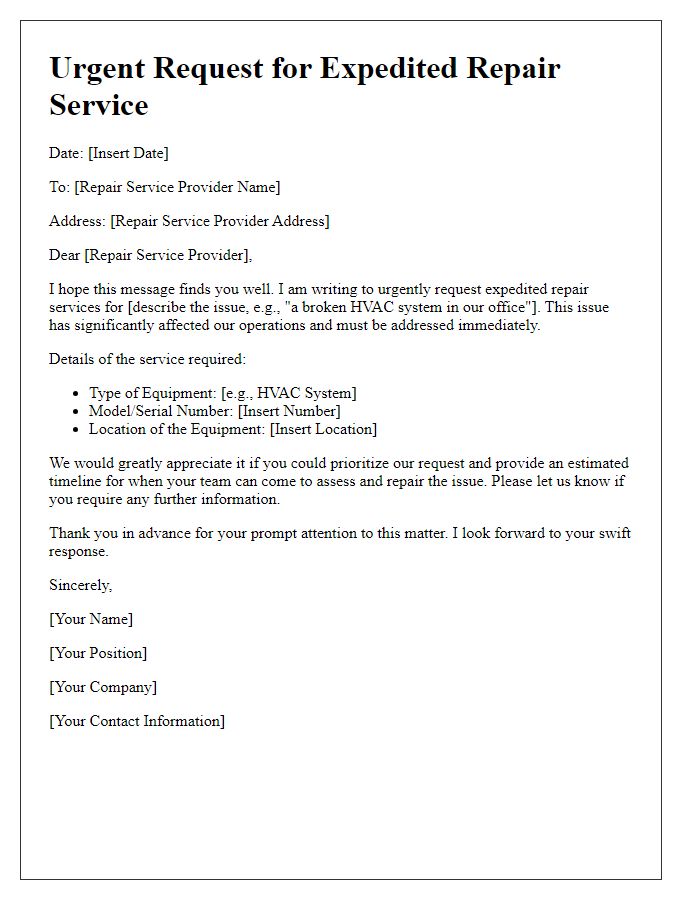Are you tired of waiting endlessly for your repair requests to be addressed? We understand how frustrating it can be when things break down, especially when it disrupts your daily routine. In this article, we'll share some proven strategies to help you expedite the repair process and ensure that your issues are resolved promptly. So, let's dive in and explore how to make those repair requests work in your favor!

Clear subject line
Efficient communication is essential for expediting repair requests in a streamlined process. A clear subject line, such as "Urgent Repair Request for Unit #2458," provides immediate context. Include specific details like the nature of the issue, location (e.g., Building A, Conference Room), and any relevant dates (e.g., reported on October 5, 2023). Highlighting key information allows maintenance teams to prioritize effectively and allocate resources appropriately. Timely follow-up can ensure that any delays are addressed, optimizing the overall repair timeline.
Specific repair details
Efficient repair request management is essential for maintaining productivity in any workplace. Common issues include malfunctioning office equipment such as printers, computers, and HVAC systems. Clear documentation of specific repair details enhances communication with service providers. For example, specifying the model number (e.g., HP LaserJet Pro MFP M426fdw) alongside a description of the problem (e.g., frequent paper jams) leads to faster resolution. Including location information, such as building name or room number (e.g., Office 305, West Wing), provides context that helps technicians prioritize their response. Additionally, noting any previous repair attempts or associated service request numbers (e.g., SR-12345) streamlines follow-up and assists in tracking recurring issues, ultimately aiding in more efficient problem-solving.
Urgency and impact explanation
Expedited repair requests can significantly enhance operational efficiency in critical environments, such as hospitals or data centers. Urgency in addressing malfunctioning equipment often relates to specific numeric benchmarks, like a 20% increase in downtime costs per hour. Equipment failures can lead to disastrous service disruptions, affecting hundreds of patients or crucial server functionalities. The impact of slow repairs often reverberates through the organization, prompting a ripple effect that may hinder productivity and reputation. Prioritizing repair requests, especially in high-stakes situations, can not only minimize financial loss but also ensure continuity of service and prevent potential crises, safeguarding both the facility's operational goals and the overall welfare of its stakeholders.
Contact information
Efficient communication can significantly expedite electronic device repair requests. Clearly state your contact information, including a permanent email address (preferably Gmail or Outlook for reliability) and a dedicated phone number (with area code included for better reachability), ensuring a direct line to the repair service. Include model numbers of the devices in question (such as iPhone 13 or Samsung Galaxy S21) and specific issues faced (e.g., screen damage, battery issues), which streamlines the process for technicians. Documenting purchase dates (ideally within warranty periods) can strengthen the request, fostering quicker resolutions. Keep all communication polite and concise to maintain an effective dialogue with repair specialists.
Request for confirmation and timeline
Repair requests often contain essential details that determine the efficiency of the process. For kitchen appliances like refrigerators or dishwashers, timely repairs are crucial, especially when hotspots like summer months lead to food spoilage. Companies like GE Appliances typically respond to repair requests within a week, depending on the service demand and part availability. Confirmation of the request can help streamline the scheduling, ensuring that technicians from local service centers have the necessary parts ready for timely repairs. Prioritizing urgent cases, such as an inoperable fridge, can significantly minimize disruptions in daily life. Clear communication about timelines and status updates further enhances customer satisfaction throughout the repair process.













Comments